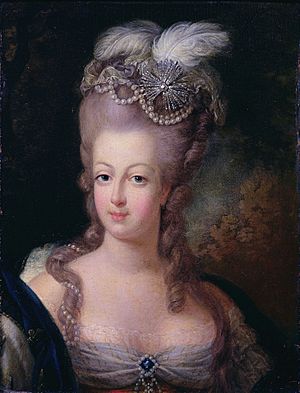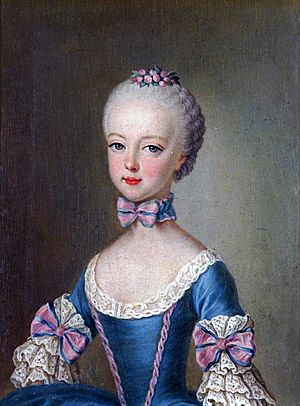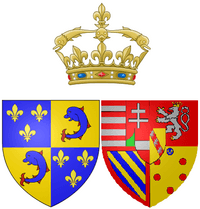Marie Antoinette facts for kids
Quick facts for kids Marie Antoinette |
|||||
|---|---|---|---|---|---|

Marie Antoinette
|
|||||
| Tenure | 10 May 1774 – 21 September 1792 | ||||
| Born | 2 November 1755 Hofburg Palace, Vienna, Austria |
||||
| Died | 16 October 1793 (aged 38) Place de la Révolution, Paris, France |
||||
| Burial | (21 January 1815, at time of Bourbon Restoration) | ||||
| Spouse | Louis XVI of France | ||||
| Issue | Marie Thérèse, Duchess of Angoulême Louis Joseph, Dauphin of France Louis XVII of France Princess Sophie |
||||
|
|||||
| House | House of Habsburg-Lorraine | ||||
| Father | Francis I, Holy Roman Emperor | ||||
| Mother | Empress Maria Theresa of Austria | ||||
Marie Antoinette was born Maria Antonia of Austria on November 2, 1755. She was an Archduchess of Austria. Later, she became the Queen of France and Navarre. She married Louis XVI of France in 1770, becoming his queen.
At first, her marriage was not easy. She was only 14 when she got married. After seven years, she had her first child, a daughter. She later had three more children, including Louis XVII of France. He was supposed to be king but never actually ruled.
Marie Antoinette was popular at first because she was charming and beautiful. But over time, the French people started to dislike her. They thought she spent too much money. People also believed she had secret friends and supported France's enemies. She was from Austria, which made some people suspicious. She became known as 'Madame Déficit' (Madam Debt). Many blamed her for France's money problems because of her expensive habits. These ideas mostly came from people who worked at the royal court.
It's hard to say exactly what caused the French Revolution. France's economy was in a very bad state. The king and queen were blamed for it. Marie Antoinette's own spending was not the main reason for the country's financial troubles. But she was famously blamed for saying "Let them eat cake," which made people even angrier. After being held in prison for months, she was executed by guillotine.
Contents
Her Life Story
Childhood in Vienna (1755-1767)
Marie Antoinette was born on November 2, 1755. She was the fifteenth child and last daughter of Maria Teresa, who was the Queen of Hungary and Empress of the Holy Roman Empire. Her mother quickly recovered after giving birth. She was said to look happy and healthy. Marie Antoinette was cared for by a wet-nurse named Constance Weber. As a child, Marie Antoinette often gave gifts to Constance and her son, Joseph. Joseph later said that Marie Antoinette once told Constance, "Good Weber, take care of your son."
Joseph Weber also mentioned that the royal children were allowed to be friends with "ordinary" children. Except for very special events, people who were not born into high families were still welcome at court. When she was young, Marie Antoinette was called "Antoine." The Austrian court where she grew up was becoming less formal. Antoine was taught by Countess Brandeis. The countess loved Marie Antoinette and was very kind to her. Antoine's first letter, written when she was 11 or 12, was to "dearest Brandeis." She signed it "your faithful pupil who loves you dearly, Antoine."
However, the countess mostly taught Antoine about good behavior and religion. She did not teach her many other subjects. Antoine also found it hard to focus. One of her friends later said that when she spoke, her words jumped around "like a grasshopper." When Antoine was 12, she could not write or speak French and German very well. But she spoke Italian well. She loved music very much. In 1759, before she turned four, Antoine sang a French song for her father at a party. Her brothers and sisters sang Italian songs. She also heard Wolfgang Amadeus Mozart play "marvellously." She was known for her beautiful dancing and the graceful way she held her head. She was taught by a famous French ballet teacher, Jean-Georges Noverre. However, she was not very good at reading.
She loved her childhood home in Vienna and missed it a lot later in life. She once said about her mother, "I love the Empress but I'm afraid of her, even from far away. When I'm writing to her, I never feel completely comfortable." She did not like her sister, Archduchess Marie "Mimi" Christine. Her mother seemed to love Mimi the most. But her relationship with her sister Maria "Charlotte" Carolina was different. They loved each other very much and were very close. A painter once said they "looked very much alike." Charlotte was stronger, and Antoine was usually thought to be prettier.
A Political Marriage (1767-1770)
In early 1767, the Empress had five daughters still at home. Marie Christine was already married. Elizabeth was 23, Amalia almost 21, Josepha was 16, Charlotte was 14, and Antoine was 12. The Empress wanted Josepha, who was gentle and pretty, to marry Charles III of Spain. But then sad things began to happen. Her son Joseph's second wife died from smallpox and was buried. After that, Maria Teresa caught smallpox and almost died herself.
Then, Maria Teresa took her daughter Josepha to pray at the tomb of Joseph's wife. Josepha was about to travel to Naples for her wedding. But the tomb had not been closed properly. Josepha suddenly caught smallpox and died, probably because of this. Elizabeth also caught the disease. She lived, but her beauty was gone. Antonia, who had caught smallpox when she was two years old and recovered, did not get the disease again.
But a bride was still needed for King Ferdinand of Naples. Maria Teresa quickly wrote a letter to Charles III of Spain. She explained what had happened. "I will give you one of my daughters to make up for the loss," she wrote. "I currently have two who could be suitable. One is Archduchess Amalia, who is said to be pretty and healthy. The other is Archduchess Charlotte, who is also very healthy and a year and seven months younger than the King of Naples." Soon, the King of Naples married Charlotte. Amalia married Louis XV's grandson, Don Ferdinand of Parma. Amalia was not happy with her mother's choice.
The only daughter left was Marie Antoinette. Empress Maria Theresa decided to use Antonia to make Austria and France more friendly. After many talks, Antonia became engaged to Louis-Auguste, who was the Dauphin of France. The duc de Choiseul from France and the Prince of Starhemberg from Austria helped arrange the wedding.
They immediately started getting Marie Antoinette ready for her marriage. Her teeth were crooked. A French dentist came to fix them. After three painful months, Marie Antoinette had a "very beautiful and straight" smile. Her thick "mountain of curls" were styled by Larsenneur, a famous hairdresser. He powdered and softened her hair. Marie Antoinette also had a high forehead, which was not considered stylish at that time. But she had a long, graceful neck.
Her education also changed. In November 1768, Abbe Jacques-Mathieu de Vermond went to Vienna to teach Antonia. She was smart, but she did not have the knowledge a future queen should have. She was also lazy and found it hard to focus. She could not read or write properly in French or German. But a year after Vermond arrived, she could speak French well enough. By the time she left Austria, she was speaking French easily, even with a small German accent. The Abbe also found that Marie Antoinette did not know much about French history. They studied it carefully together. In the end, Marie received a fairly good education.
Her Death
Marie Antoinette was publicly executed by guillotine for treason in Paris, France, on October 16, 1793. This happened months after her husband's death. Her youngest son, Louis-Charles, later died from tuberculosis and malnutrition during the revolution. She was buried in the Saint Denis Basilica. Her oldest daughter, Marie Therese, was the only one of their immediate family to survive the revolution.
Titles from Birth to Death
- November 2, 1755 – April 19, 1770: Her Royal Highness Archduchess Maria Antonia of Austria
- April 19, 1770 – May 10, 1774: Her Royal Highness The Dauphine of France
- May 10, 1774 – October 1, 1791: Her Most Christian Majesty The Queen of France and Navarre
- October 1, 1791 – September 21, 1792: Her Most Christian Majesty The Queen of the French
- September 21, 1792 – January 21, 1793: Madame Capet
- January 21, 1793 – October 16, 1793: La Veuve ("the widow") Capet
Images for kids
-
Watercolor of Archduchess Maria Antoina at the age of 7 (portrait by Jean-Étienne Liotard, 1762)
-
Marie Antoinette en chemise, portrait of the queen in a muslin dress (by Louise Élisabeth Vigée Le Brun, 1783). This portrait was criticized for showing improperly informal attire for a queen
-
Storming of the Bastille and arrest of Governor Bernard-René de Launay, 14 July 1789
-
Marie Antoinette on her way to the guillotine (pen and ink by Jacques-Louis David, 16 October 1793)
See also
 In Spanish: María Antonieta de Austria para niños
In Spanish: María Antonieta de Austria para niños












